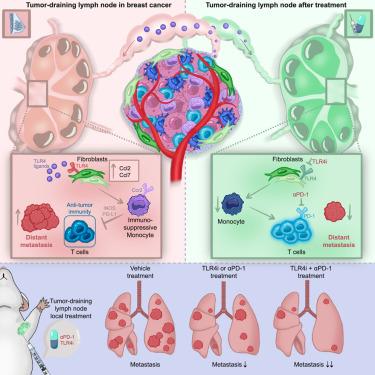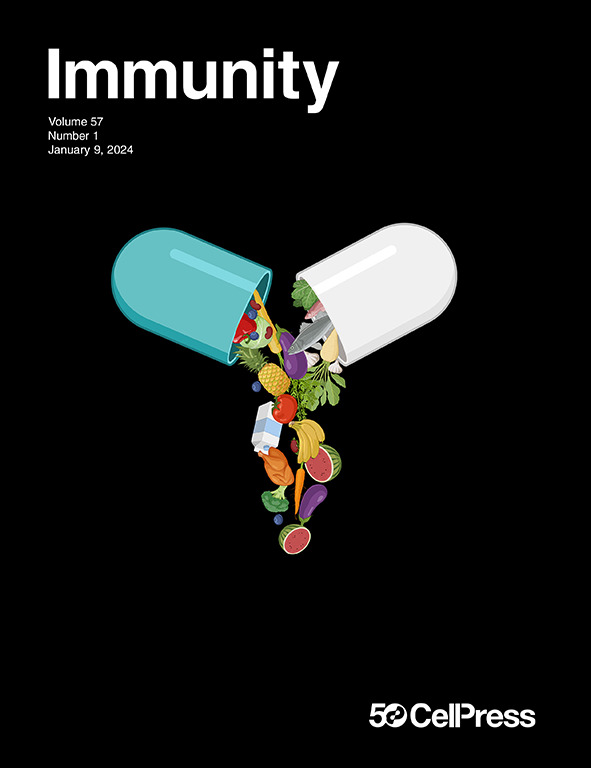A TLR4-dependent fibroblast-monocyte axis in tumor-draining lymph nodes contributes to metastasis in triple-negative breast cancer
IF 26.3
1区 医学
Q1 IMMUNOLOGY
引用次数: 0
Abstract
Tumor-draining lymph nodes (TDLNs) are sites of anti-tumor immune priming as well as metastases. Here, we examined how the cellular networks within TDLNs are reorganized in triple-negative breast cancer (TNBC). We found that the frequencies of programmed death ligand 1 high (PD-L1hi) monocytes increased in TDLNs of metastatic TNBC mouse tumors. Fibroblastic reticular cell (FRC) subtypes heightened the expression of the chemokines CCL2 and CCL7, supporting the homing of CCR2+ monocytes. These monocytes suppressed T cells in vitro via PD-L1 and inducible nitric oxide synthase (iNOS). Spatial transcriptomics revealed immunosuppressive FRC-monocyte niches in vascularized and T cell areas. Tumor-associated Toll-like receptor (TLR) 4 ligands induced CCL2 and CCL7 expression by FRCs to promote monocyte recruitment. Localized TLR4 inhibition in combination with anti-programmed cell death protein 1 (αPD-1) therapy reduced monocyte homing and boosted T cell function, ultimately attenuating lung metastases. Monocytes accumulate in human TNBC TDLNs, with evidence of a FRC-monocyte axis, and a TLR4 ligand signature is predictive of poor survival outcomes in TNBC patients. Thus, metastatic TNBC can reprogram lymph nodes (LNs) to facilitate PD-L1-mediated immune evasion and metastasis.

肿瘤引流淋巴结中tlr4依赖的成纤维细胞单核细胞轴有助于三阴性乳腺癌的转移
肿瘤引流淋巴结(tdln)是抗肿瘤免疫启动和转移的部位。在这里,我们研究了三阴性乳腺癌(TNBC)中tdln内的细胞网络是如何重组的。我们发现在转移性TNBC小鼠肿瘤的tdln中,程序性死亡配体1高(pd - l1)单核细胞的频率增加。纤维母细胞网状细胞(FRC)亚型升高趋化因子CCL2和CCL7的表达,支持CCR2+单核细胞的归巢。这些单核细胞通过PD-L1和诱导型一氧化氮合酶(iNOS)在体外抑制T细胞。空间转录组学显示在血管化区和T细胞区有免疫抑制的frc -单核细胞壁龛。肿瘤相关toll样受体(TLR) 4配体通过FRCs诱导CCL2和CCL7表达,促进单核细胞募集。局部TLR4抑制联合抗程序性细胞死亡蛋白1 (αPD-1)治疗可减少单核细胞归巢,增强T细胞功能,最终减轻肺转移。单核细胞在人类TNBC tdln中积累,有证据表明frc -单核细胞轴和TLR4配体特征可预测TNBC患者的不良生存结果。因此,转移性TNBC可以重编程淋巴结(LNs),以促进pd - l1介导的免疫逃避和转移。
本文章由计算机程序翻译,如有差异,请以英文原文为准。
求助全文
约1分钟内获得全文
求助全文
来源期刊

Immunity
医学-免疫学
CiteScore
49.40
自引率
2.20%
发文量
205
审稿时长
6 months
期刊介绍:
Immunity is a publication that focuses on publishing significant advancements in research related to immunology. We encourage the submission of studies that offer groundbreaking immunological discoveries, whether at the molecular, cellular, or whole organism level. Topics of interest encompass a wide range, such as cancer, infectious diseases, neuroimmunology, autoimmune diseases, allergies, mucosal immunity, metabolic diseases, and homeostasis.
 求助内容:
求助内容: 应助结果提醒方式:
应助结果提醒方式:


